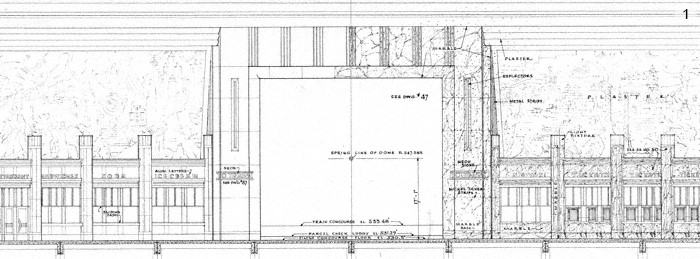
The Glass Storybook and the Great Menagerie: The Art of Union Terminal
The Art of Union Terminal
When Paul Cret and Roland Wank reworked the original Union Terminal design, they created space inside the terminal for a vast collection of public art. The biggest set of these spaces was set aside for a series of murals that would depict the cultural heritage of the United States and Cincinnati, with a particular emphasis on local industry. These murals would make an immediate and lasting impression on a visitor passing through the terminal. It was important to terminal officials that these murals were of the highest quality and spoke to the importance of Cincinnati. A separate contract for art in the various public rooms in the terminal was also issued, with the same intentions as above. Cincinnati was no longer a place to be avoided, but enjoyed, while traveling. The art commissions, likely one of the largest of the inter-war period, totaled roughly 18,150 square feet of artwork for the new station.
Winold Reiss
The artist selected for the large mural project was Winold Reiss. Reiss had emigrated from Germany in 1913 and had established himself as a portraitist and interior decorator. Reiss had particularly made a name for himself by painting Native Americans in the American West and through his portrait work in Harlem. The murals themselves were executed in glass mosaic tile. This format would provide exceptionally vivid colors that would not fade with age or be difficult to maintain, something ideal in a potentially dirty, smoke-filled train station. Reiss would work with the Ravenna Tile Company of New York to create the magnificent murals for the new terminal. Reiss's chief responsibility in the project was the creation of the one-third scale cartoons, which Ravenna would use as a reference to create the full scale mosaic tile murals.
Ultimately there was space for 23 mosaic murals in the terminal building. Reiss would photograph local business and create his cartoons from these images, almost directly. For the two massive rotunda murals, Reiss created two timelines: one of the history of the United States, from the Native Americans to the ‘modern’ citizen, and one of Cincinnati, from settlement to the ‘modern’ period. In these two murals Reiss planted several real life figures, from a local engineer, a Union Terminal construction worker, even his brother, to, to three Blackfoot Native Americans. Reiss preferred to work from the real thing, not creating characters from scratch. As such, he drew on previous work to chance opportunities while photographing local industry.
Installing Reiss’s work
The mosaics were created from blow-ups of Reiss's one-third scale cartoons, which when finished were shipped to the studio. Here workers would grid out the images and begin matching tiles, or tesserae, to the colors found in Reiss’ original. Many of these pieces were roughly the size of a nickel and were positioned and trimmed individually to achieve the desired appearance. The murals are silhouette mosaics, which mean the main elements of the murals are fully done in tesserae, but that the backgrounds are colored plaster. This saved money and provided and interesting contrast between the glass tile and plaster.
Workers assembled the tesserae on paper guides, using a sheet that looked a little like a color by number sheet to place everything correctly. They would lightly glue the paper to the tesserae to keep it from shifting. The murals were done in roughly two-foot-square sections, and as each section was finished, another sheet was glued to the exposed side to ensure nothing came loose during transport to the construction site. Once here, the mural assembly team would coat the walls where the murals were to go with a thin layer of plaster. Once the plaster was up, the paper on the back of the design was removed and pressed into the plaster. As the plaster dried, the paper that remained on the front of the section was removed, leaving the finished section in place. They worked from the bottom up and the murals would be carefully inspected to ensure that everything was in its proper place.
Reiss, given his background as an interior designer, provided suggestions on the design the terrazzo floor patterns found throughout the building and provided input as to the color scheme of the rotunda dome. Reiss’ designs would eventually account for an astonishing 11,908 square feet of art work!
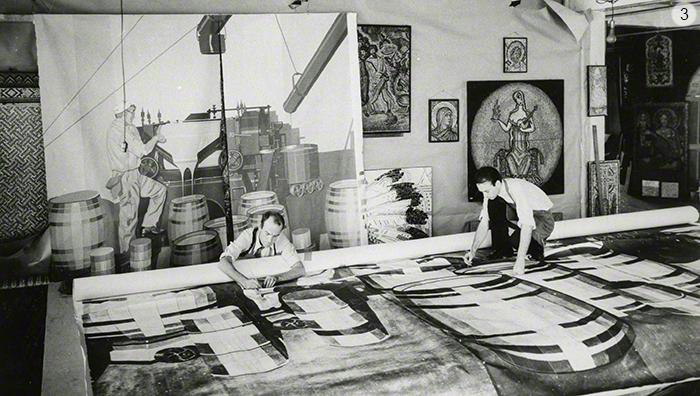
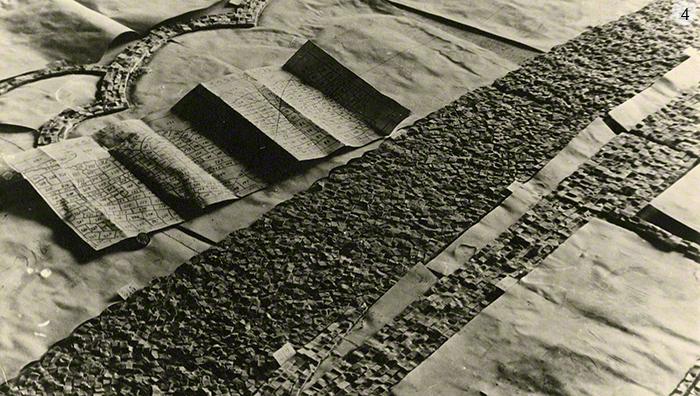
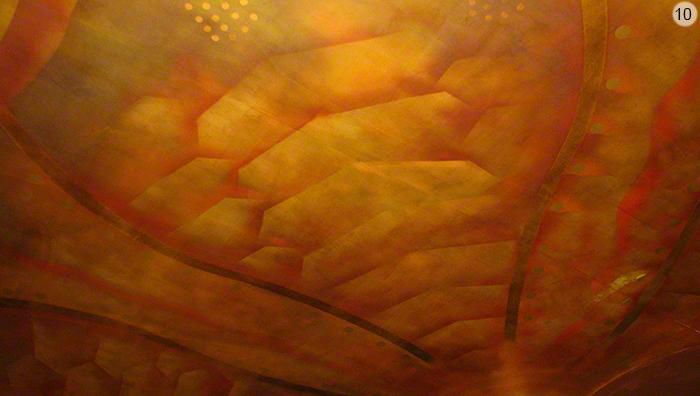
Pierre Bourdelle
The artist who received the contract for the art in the public rooms was a Frenchman named Pierre Bourdelle. Bourdelle was asked to decorate the ceilings in the private dining rooms, the formal dining room and the hall that lead to it, the paintings that hung along the top of the wall in the cafeteria, hand cut linoleum designs for the women’s restroom vestibule by the dining rooms, the panels for the women’s lounge (along with its hand cut wall paper) and the newsreel theater. Bourdelle would ultimately create 5,496 square feet of work for Union Terminal, by far the largest single project of his career.
Unlike Reiss's work, Bourdelle’s would dwell in fantasy, conjuring up jungle scenes, mermaids, and fanciful flowers. The colors of these murals would be vivid and in some cases, the materials exotic. The ceiling murals were painted oil-on-canvas, using bright colors, some metallic, which he painted and then glued to the ceiling. In the Formal Dining room, Bourdelle painted the largest of the ceiling murals, a map of Cincinnati, bounded on the edges with forms of transportation and landmarks of the city. The map is a curiosity in that it is reversed, east having gone west, much like the famed reversal of the Grand Central Terminal concourse mural. For the dining rooms upstairs, he painted three ceiling murals, all featuring elaborate and fanciful plant life. In the cafeteria he painted a series of murals showing food themes, from roosters to pies and even pizza!
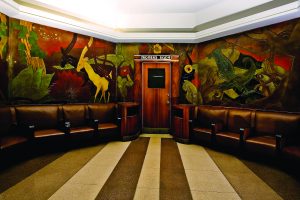 For the Women’s Lounge, Dining Room Alcove, and Newsreel Theater, Bourdelle created something truly unique. Using linoleum, Bourdelle carved wall murals which depicted mermaids for the Newsreel Theater, a jungle scene for the Alcove, and various flora in the Women’s Lounge. These linoleum panels were a favorite medium of Bourdelle, who believed in a permanence of material for public art, and the durable linoleum fit the bill.
For the Women’s Lounge, Dining Room Alcove, and Newsreel Theater, Bourdelle created something truly unique. Using linoleum, Bourdelle carved wall murals which depicted mermaids for the Newsreel Theater, a jungle scene for the Alcove, and various flora in the Women’s Lounge. These linoleum panels were a favorite medium of Bourdelle, who believed in a permanence of material for public art, and the durable linoleum fit the bill.
To create these linoleum murals, Bourdelle would start with a sheet of linoleum, and using tools, would score and carve the design into the linoleum. He would then sand then surface and coat the entire mural in a primer. After that he would paint the mural and then lacquer it to protect it. The finished mural would appear almost like embossed leather.
Bourdelle is also notable in that he created designs for the murals Reiss worked on. Currently, it is not clear how the artistic contracts were let, and Bourdelle seems to have compiled a portfolio for the entire mural project. His designs survive in his scrapbook and provide an interesting counter point to Reiss’s slightly more heroic representations.
Restoring Bourdelle’s work
In 2009 and 2010, four of Bourdelle’s murals were cleaned and restored as a part of Project One. The murals, which had not been cleaned in over 75 years, carried the cigarette smoke, dirt and grime of another age. Experts carefully cleaned and repaired the murals and brought them back to their original luster. After months of diligent work, the murals were unveiled in 2010 and can now be seen occasionally during public and private events.
William E. Hentschel
Another feature of the facility is the Rookwood Tea Room, today the Rookwood Ice Cream Parlor. Designed by well-known Rookwood artist William E. Hentschel, the design was one of the last architectural tile installations the company would do before declaring bankruptcy. The room features floor-to-ceiling tile in a mint green, pale gray, and mauve color scheme. The design features dragonflies and flowers and partitioned seating. The room originally provided tea, coffee and light refreshments. During World War II, the room served as the primary space of the USO Troops-in-Transit Lounge that was here. Following the end of the war, the room was used for different functions, from food service to a game room. During the years when the building was a shopping center, it was a G. D. Ritzy’s ice cream and chili parlor. Since Union Terminal has been home to Cincinnati Museum Center, the room has been used as an ice cream parlor.
Maxfield Keck
Two other works of art form part of Union Terminal’s unique and memorable façade. The two bas reliefs flanking the rotunda were carved by Maxfield Keck and his team in 1932. Once the limestone of the exterior was in place, Keck had scaffolding erected and he carved the murals over a period of several months. Once complete, the murals represented transportation and commerce.
Museum Admission
Includes Cincinnati History Museum, Museum of Natural History & Science and The Children's Museum
| Adult: | $22.50 |
| Senior: | $15.50 |
| Child: | $15.50 |
| Member Adult: |
FREE |
| Member Child: |
FREE |
Members receive discounts!
Become a Member today to save on programs, exhibits and films throughout CMC.
Museum Hours
Open Thursday – Monday
10 a.m. to 5 p.m.
Closed Tuesday and Wednesday
Closed Thanksgiving Day and Christmas Day
Member’s-only early entry: Saturdays at 9 a.m.
Customer Service Hours:
Monday – Sunday, 9 a.m. to 5 p.m.

